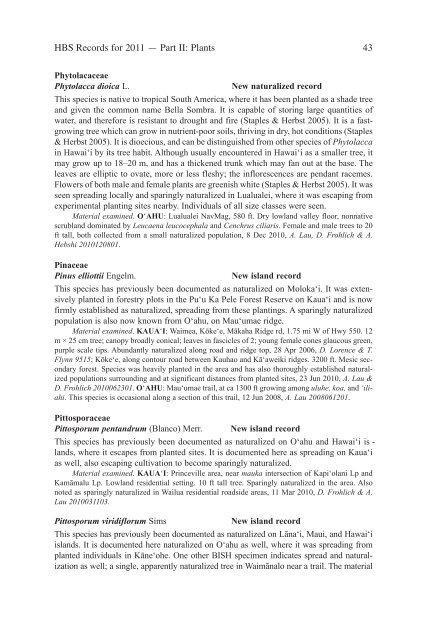OCCASIONAL PAPERS - Hawaii Biological Survey - Bishop Museum
OCCASIONAL PAPERS - Hawaii Biological Survey - Bishop Museum
OCCASIONAL PAPERS - Hawaii Biological Survey - Bishop Museum
Create successful ePaper yourself
Turn your PDF publications into a flip-book with our unique Google optimized e-Paper software.
HBS Records for 2011 — Part II: Plants 43<br />
Phytolacaceae<br />
Phytolacca dioica l. New naturalized record<br />
This species is native to tropical South america, where it has been planted as a shade tree<br />
and given the common name Bella Sombra. It is capable of storing large quantities of<br />
water, and therefore is resistant to drought and fire (Staples & Herbst 2005). It is a fastgrowing<br />
tree which can grow in nutrient-poor soils, thriving in dry, hot conditions (Staples<br />
& Herbst 2005). It is dioecious, and can be distinguished from other species of Phytolacca<br />
in Hawai‘i by its tree habit. although usually encountered in Hawai‘i as a smaller tree, it<br />
may grow up to 18–20 m, and has a thickened trunk which may fan out at the base. The<br />
leaves are elliptic to ovate, more or less fleshy; the inflorescences are pendant racemes.<br />
flowers of both male and female plants are greenish white (Staples & Herbst 2005). It was<br />
seen spreading locally and sparingly naturalized in lualualei, where it was escaping from<br />
experimental planting sites nearby. Individuals of all size classes were seen.<br />
Material examined. O‘AHU: lualualei NavMag, 580 ft. dry lowland valley floor, nonnative<br />
scrubland dominated by Leucaena leucocephala and Cenchrus ciliaris. female and male trees to 20<br />
ft tall, both collected from a small naturalized population, 8 dec 2010, A. Lau, D. Frohlich & A.<br />
Hebshi 2010120801.<br />
Pinaceae<br />
Pinus elliottii Engelm. New island record<br />
This species has previously been documented as naturalized on Moloka‘i. It was extensively<br />
planted in forestry plots in the Pu‘u Ka Pele forest reserve on Kaua‘i and is now<br />
firmly established as naturalized, spreading from these plantings. a sparingly naturalized<br />
population is also now known from o‘ahu, on Mau‘umae ridge.<br />
Material examined. KAUA‘I: Waimea, Kōke‘e, Mākaha ridge rd, 1.75 mi W of Hwy 550. 12<br />
m × 25 cm tree; canopy broadly conical; leaves in fascicles of 2; young female cones glaucous green,<br />
purple scale tips. abundantly naturalized along road and ridge top, 28 apr 2006, D. Lorence & T.<br />
Flynn 9515; Kōke‘e, along contour road between Kauhao and Kā‘aweiki ridges. 3200 ft. Mesic secondary<br />
forest. Species was heavily planted in the area and has also thoroughly established naturalized<br />
populations surrounding and at significant distances from planted sites, 23 Jun 2010, A. Lau &<br />
D. Frohlich 2010062301. O‘AHU: Mau‘umae trail, at ca 1300 ft growing among uluhe, koa, and ‘iliahi.<br />
This species is occasional along a section of this trail, 12 Jun 2008, A. Lau 2008061201.<br />
Pittosporaceae<br />
Pittosporum pentandrum (Blanco) Merr. New island record<br />
This species has previously been documented as naturalized on o‘ahu and Hawai‘i is -<br />
lands, where it escapes from planted sites. It is documented here as spreading on Kaua‘i<br />
as well, also escaping cultivation to become sparingly naturalized.<br />
Material examined. KAUA‘I: Princeville area, near mauka intersection of Kapi‘olani lp and<br />
Kamāmalu lp. lowland residential setting. 10 ft tall tree. Sparingly naturalized in the area. also<br />
noted as sparingly naturalized in Wailua residential roadside areas, 11 Mar 2010, D. Frohlich & A.<br />
Lau 2010031103.<br />
Pittosporum viridiflorum Sims New island record<br />
This species has previously been documented as naturalized on lāna‘i, Maui, and Hawai‘i<br />
islands. It is documented here naturalized on o‘ahu as well, where it was spreading from<br />
planted individuals in Kāne‘ohe. one other BISH specimen indicates spread and naturalization<br />
as well; a single, apparently naturalized tree in Waimānalo near a trail. The material

















